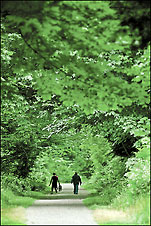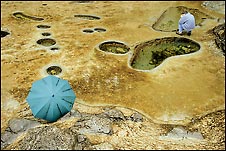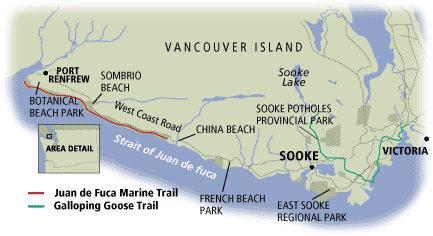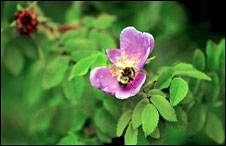 |
|
|
|
| home | |
| parks | |
| lodging | |
| tourism articles | |
| recreation | gateway |
| restaurants | mountain | whale watching |
| businesses | hiking |
| community | |
| add listing | |
| web hosting | |
| .com domains | |
| webmaster | |
|
|
|
Sooke:
tourism: travel article:
hiking Please submit any articles you wish considered for publication in our archive. All articles must be sent in electronic format and list proper credits. We will consider all articles for publication that are not just repeating what is already published here and also not merely written to promote a particular business ... the objective of this article section is to promote Sooke!! Take a Hike Sooke is central to kilometers galore of superb coastal wandering SOOKE, B.C. -- The often chaotic confluence of solid earth and brine is what makes the seashore so rich and fascinating, and one of the most spectacular places to witness this phenomenon is on the southern coast of "the rock," as locals sometimes call Vancouver Island.
Say what you may about secondary sewage treatment (as in Victoria's lack thereof), B.C. traffic (as in nightmarish) and logging practices (as in giant clearcuts). But Canada has done a wonderful job of making parks on Vancouver Island's southern shores, which are situated by the town named after a Coast Salish band called the T'sou-kes and pronounced like fluke, juke or, as they pronounce it north of the border, about. Fact is, there are about as many cool places to hike and explore along the shore around Sooke as red coats in an RCMP band. These include one of Canada's premier day hikes -- the rocky, wave-washed 10-kilometer (6.2-mile) Coast Trail in East Sooke Regional Park, which is well known to locals but not so much to visitors. Very well known is the rugged and superbly wild 47-kilometer (29-mile) Juan de Fuca Marine Trail west of Sooke and its marvelous and easily accessible China, Sombrio and Botanical beaches -- the latter featuring some of the most impressive tidepools on the Northwest Coast. Sooke is also the last-chance full-service outfitting stop for backpackers en route to the southern end of the internationally famous 75-kilometer (46-mile) West Coast Trail, which begins 70 kilometers (43 miles) west of Sooke. |
|
||||||||||||||
Other fine regional and provincial parks along the shore include: Witty's Lagoon, an ancient aboriginal village site; Whiffen Spit, which juts into the middle of Sooke Harbour (both prime birding locales); Roche Cove and the adjacent Matheson Lake regional parks, which connect a forest lake and its outlet creek to Sooke Basin; and French Beach, another interesting tidepool locale. These are places that define the rugged character of the south end of Vancouver Island. Here you can see petroglyphs and shell middens left by ancestors of the First Nations people, shoreline stands of red-barked madrona and wind-twisted Sitka spruce, seals and sea lions lounging on offshore rocks and, if you're fortunate, a pod of orca or gray whales. There are more terrestrial features to check out as well, including the 60-kilometer (37-mile) Galloping Goose Trail, a wildly popular hiking, running and bicycling path along an old railway bed between Victoria and the former mining area of Leechtown north of Sooke. Also north of town is a longtime cooling-off spot on a canyon of the Sooke River, the Sooke Potholes Provincial Park. "We're very fortunate," says Ron Armstrong, one of the founders of the hiking group Victoria Club Tread, which schedules regular hikes to all the parks and trails around Sooke. "There's a tremendous variety of trails -- shore, lakes, hills -- all clean and green and so close. It's one of the things that attracts people to the area." Furthermore, this regional parks system will expand over the next few years with a current effort known as the Sea to Sea initiative. The plan is to acquire more land to extend the huge Sooke Hills Wilderness, which is not yet open to the public, into a park that will stretch from Sooke Basin to the Saanich Inlet north of Victoria. Parks and trails, however, are not the only attractions in the region.
Originally a logging and fishing town now increasingly dependent on tourism, Sooke (population 11,000) has long been synonymous with salmon. Spots such as Possession and Otter points, Donaldson Island and Beechey Head still produce excellent fishing for chinook, or "springs" as Canadians call them, up to 60 pounds, as well as coho. With its wild coast, sea kayaking is popular. There are two golf courses, at 9 and 18 holes. There are mountain biking, surfing and camping opportunities. For just plain relaxing, Sooke offers notable accommodations. The venerable Sooke Harbour House, an inn and restaurant on the water, is perennially rated among the best on the continent for its food and ambience. Bed-and-breakfast inns around Sooke are about as numerous as crumbs around a toaster in the morning. "A lot of people come just to get away from their busy lifestyles. Sooke is a good weekend getaway," says Norm Feil, who with his wife, Helen, operates the Tides of Seagirt B&B in East Sooke, where many muddy hiking boots have prompted a sign at the entrance "Please Remove Your Footwear."
"We get a lot of people who like to hike the trails," Feil says. "They'll do the Coast Trail here or go down when the tide is right to Botanical Beach. Or they'll take a couple-hour hike to Sombrio or China Beach." Whatever you do when you visit Sooke, there are a handful of places that should not be missed. Foremost among them is the Juan de Fuca Trail and its beaches, especially Botanical Beach at its west end. Although 47 kilometers (29 miles) long, the trail is designed as much for day use as for backpacking, with four primary parking and access points spread along its length from east to west: China Beach, Sombrio Beach, Parkinson Creek and Botanical Beach. "A great stretch is China Beach to Mystic Beach (about 1.2 miles)," says Scot Taylor, long time Sooke kayak guide and operator of Rush Adventure Center in Sooke. "You've got a suspension bridge to go over, a waterfall. I highly recommend the Juan de Fuca Trail." When hiking any length of the trail, you must be aware of the tides, since some beach routes can be cut off during the highs. Botanical Beach's magical tidepools can be seen only at low tide, and the lower the better. Reached by a 10- or 12-minute hike from the trailhead, the beach is a series of shelves in a wave-washed, curiously shaped rocky headland, where dozens of pothole-like pools have been carved out over the centuries. These apparently were created by rocks gathering in low spots and being shoved around corrosively by the sea. A fascinating variety of colorful marine life thrives inside these potholes, including brilliantly purple sea urchins that also over eons have carved deep pockets in the rock, purple sea stars, aquamarine anemones, brown chitons, black mussels and white barnacles. "It's amazing. It's like a moonscape," says Joel Prive of Victoria, whom we encountered peering into a pothole recently. "I can't get over it. How did they get like that? It's my first time here, but I'll be back." Caution is urged while exploring. Your return to dry land can be cut off by rising tides. It's tempting to venture out to the edge of the rocks, where the sea crashes in plumes and veils of white. However, rogue waves occasionally roar in, so stay back a bit. But do peer out at the turbulent edge. Look for seals, seal lions and whales, and savor the essence of "the rock."
|
|||||||||||||||



